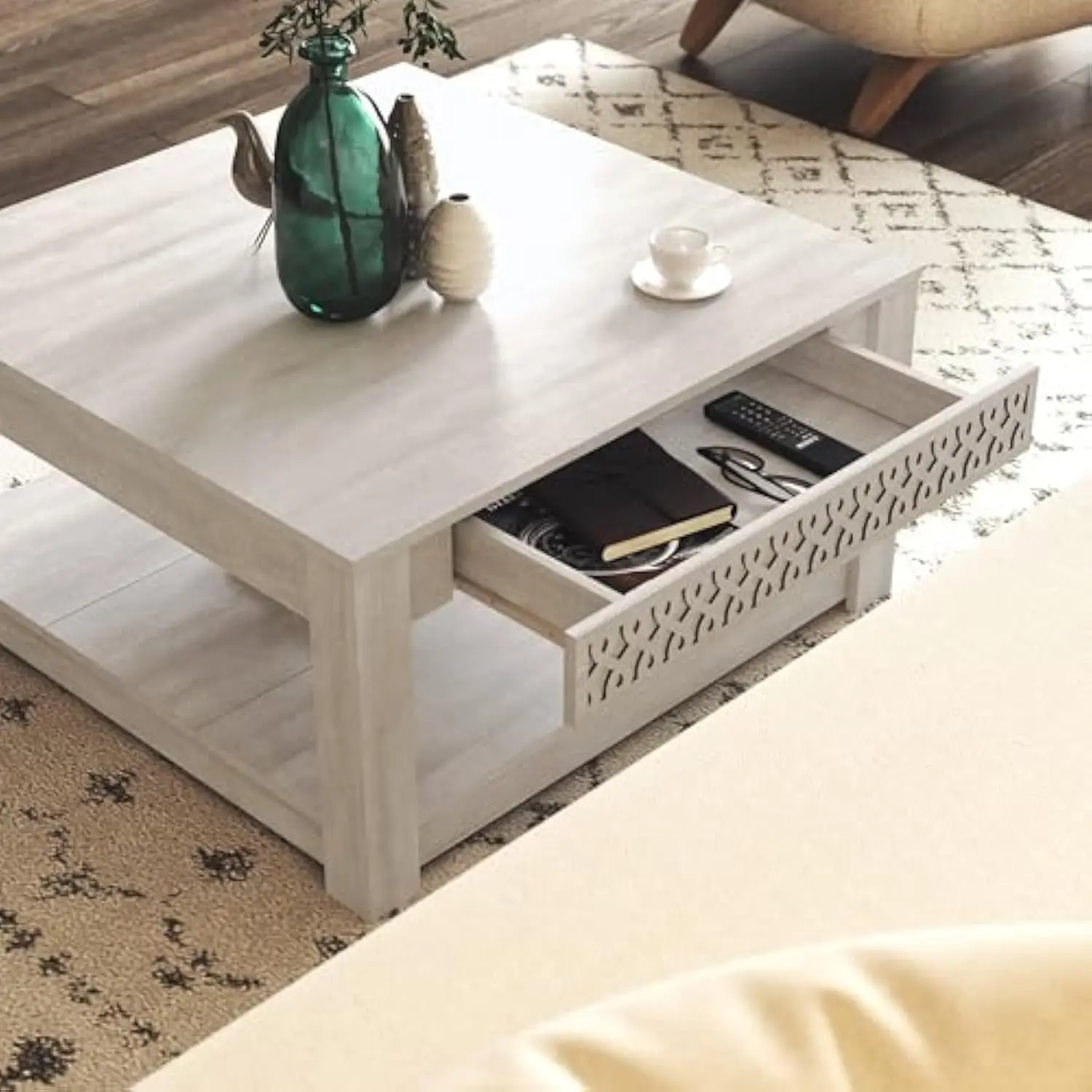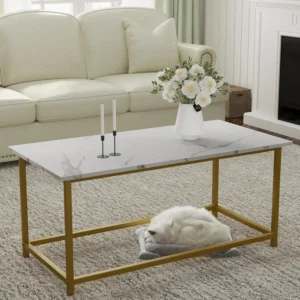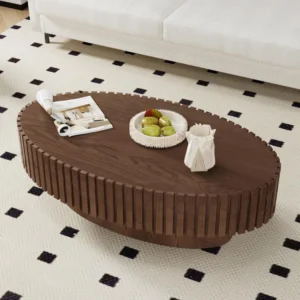Introduction
When investing in a coffee table, durability should be at the top of your priority list. A truly durable coffee table can withstand daily challenges including scratches from keys or decor items, heat from coffee mugs, water rings from beverages, and impacts from everything from dropped remotes to children’s toys. The most durable materials for coffee tables include solid hardwoods like oak and walnut, metals such as steel and wrought iron, natural stones like granite and marble, tempered glass, and concrete.
Coffee tables occupy a central position in most living rooms, enduring more use and potential abuse than almost any other piece of furniture. Finding the right balance between durability and style is crucial, particularly when considering intelligent black mid-century coffee tables that blend form with function.
The “best” material ultimately depends on your specific lifestyle factors. A household with young children might prioritize different durability aspects than a design enthusiast living alone. This comprehensive guide will help you understand the durability characteristics of various materials, matching them to your specific needs to ensure your coffee table remains a beautiful, functional centerpiece for years to come.
Why Durability Is Essential for Coffee Tables
Coffee tables endure significant daily wear and tear that other furniture pieces simply don’t experience. They’re subjected to hot cups and plates, wet glasses creating condensation rings, feet propped up after a long day, and heavy decorative objects that get moved around frequently. In homes with children or pets, these tables face additional challenges from climbing, playing, spills, and scratches.
From a financial perspective, investing in a durable coffee table makes excellent sense:
- Quality durable tables may cost more initially but often last decades rather than years
- Replacement costs for cheaper, less durable options add up over time
- Repairs and refinishing for damaged tables can be expensive and time-consuming
- Durable materials typically maintain their appearance longer, preserving your living room’s aesthetic
As central focal points in most living spaces, coffee tables attract immediate attention when damaged. Scratches, stains, or chips on your table create a negative impression that’s hard to ignore, no matter how beautiful the rest of your room appears.
The durability requirements for your coffee table should align with your household composition. A busy family home with children and pets needs maximum scratch and impact resistance, while a sophisticated apartment used for entertaining might prioritize heat and stain resistance for protection against wine glasses and hot plates.
Solid Hardwood: The Timeless Durable Choice
Solid hardwood represents the gold standard for coffee table durability, providing an excellent balance of strength, repairability, and timeless appeal. The distinction between hardwoods and softwoods is crucial when evaluating durability. True hardwoods come from deciduous trees (those that lose their leaves) and typically grow slower, resulting in denser, more durable wood than softwoods from evergreen trees.
Superior Hardwood Options for Durability
- Oak: Exceptionally durable with prominent grain patterns; resistant to wear, dents and scratches
- Maple: Extremely hard with a tight, uniform grain; highly resistant to abrasion
- Walnut: Moderately hard with rich color that improves with age; good shock resistance
- Teak: Natural oils make it highly water-resistant; excellent for long-term durability
- Sheesham: Dense Indian rosewood with striking grain patterns and excellent durability
Hardwood Durability Characteristics
Scratch Resistance: Most hardwoods offer good scratch resistance, with maple and oak ranking among the most resistant. Scratches that do occur can usually be sanded and refinished.
Heat Resistance: Hardwoods provide moderate heat resistance. Brief contact with hot mugs typically won’t damage them, though trivets should be used for very hot items.
Water Resistance: With proper finishing (polyurethane, lacquer, or oil), hardwoods resist water damage well. Quick cleanup of spills prevents problems, and even water rings can often be removed with refinishing.
Impact Resistance: Hardwoods typically dent rather than crack or shatter when impacted. This resilience allows them to absorb shock while maintaining structural integrity.
For optimal durability, regular maintenance is essential. This includes dusting with a soft cloth, cleaning with appropriate wood cleaners, and occasionally refreshing the finish. Many quality mid-century modern solid wood coffee tables are designed to last generations when properly maintained, making them both an aesthetic choice and a practical investment.
Metal Coffee Tables: Industrial Strength and Style
Metal coffee tables combine exceptional durability with sleek, modern aesthetics. These tables are often the go-to choice for those seeking maximum resilience against daily wear and tear. Different metals offer varying levels of durability and distinct visual appeal.
Common Metals Used in Coffee Tables
- Steel: Exceptionally strong and heavy; available in various finishes including stainless, brushed, or powder-coated
- Wrought Iron: Traditional, extremely durable material with ornate possibilities; heavier than other options
- Aluminum: Lightweight yet strong; naturally resistant to corrosion; modern appearance
- Brass: Warm appearance that develops a patina over time; antimicrobial properties; moderately strong
Metal Durability Characteristics
Scratch Resistance: Most metals provide excellent scratch resistance, particularly steel and wrought iron. Some softer metals like brass may show scratches more easily but often develop a desirable patina over time.
Heat Resistance: Metal coffee tables excel at heat resistance. Hot mugs, plates, and cookware can typically be placed directly on metal surfaces without damage, though extreme temperature changes should still be avoided.
Water/Rust Resistance: Resistance varies significantly by metal type and finish. Stainless steel, aluminum, and properly sealed brass resist water damage well, while untreated iron can rust when exposed to moisture. Understanding common wood finishes coffee tables and metal finishes helps you make informed decisions about long-term care.
Impact Resistance: Metals offer superior impact resistance, rarely denting under normal household use. Steel and wrought iron are virtually indestructible in typical home settings.
The finish applied to metal significantly affects its durability. Powder coating provides superior protection compared to paint, creating a hard finish resistant to chipping, scratching, fading, and corrosion. Proper cleaning with appropriate metal cleaners helps maintain the appearance and integrity of metal coffee tables for decades.
Stone and Concrete: Virtually Indestructible Surfaces
Stone coffee tables represent the pinnacle of durability, offering surfaces that can last generations with minimal signs of wear. These natural materials bring unmatched resilience and unique aesthetic character to living spaces.
Natural Stone Options
- Granite: Extremely hard and dense with varied speckling patterns; highly resistant to scratches, heat, and stains when properly sealed
- Marble: Elegant with distinctive veining; moderately hard but vulnerable to acidic substances; requires more maintenance
- Slate: Rustic appearance with unique texture; excellent durability with proper sealing
- Travertine: Natural porous stone with warm tones; requires sealing but very durable when maintained
Engineered Stone Options
- Quartz: Engineered stone combining natural quartz with resins; non-porous and extremely durable
- Concrete: Contemporary industrial appearance; can be sealed for stain resistance; extremely durable and customizable
Stone Durability Characteristics
Scratch Resistance: Most stones, particularly granite and quartz, offer exceptional scratch resistance. Even knife blades rarely leave marks on properly maintained stone surfaces.
Heat Resistance: Stone coffee tables excel at heat resistance. Hot cookware, mugs, and plates can typically be placed directly on stone without damage, though extreme temperature changes should be avoided with some stones.
Water/Stain Resistance: Natural stones vary in porosity and stain resistance. Granite and quartz resist stains well when sealed, while marble is more vulnerable to acidic substances like wine or lemon juice. Regular sealing is essential for maintaining stain resistance in natural stones.
Impact Resistance: Stone tops resist scratches exceptionally well but can chip at edges if struck with sufficient force. Rounded edges help mitigate this vulnerability.
The selection of mid-century modern marble top coffee tables continues to grow as homeowners recognize the perfect marriage between timeless design and incredible durability. Stone tables do require consideration of weight—they’re significantly heavier than other options, sometimes necessitating stronger floor support and making them difficult to move.
Tempered Glass: Surprising Strength and Elegance
Contrary to popular belief, glass coffee tables can be remarkably durable when made with tempered glass. This specialized manufacturing process creates glass that’s significantly stronger than standard glass, offering surprising resilience for everyday use.
Myth vs. Reality: Glass Durability
Myth: Glass coffee tables are fragile and break easily.
Reality: Tempered glass is designed to be 4-5 times stronger than regular glass and can withstand significant weight and regular use.
Myth: Glass tables are easily scratched.
Reality: Quality tempered glass resists scratching from most household items, though it’s not completely scratch-proof.
Myth: Glass shatters dangerously.
Reality: When tempered glass does break, it fractures into small, relatively safe cuboid pieces rather than sharp shards.
Tempered Glass Durability Characteristics
Scratch Resistance: Moderate to good. While harder than regular glass, tempered glass can still be scratched by harder materials like sand or metal. Using coasters and placemats helps maintain its pristine appearance.
Heat Resistance: Good for brief exposure to hot items, though extreme temperature changes can cause breakage. Using trivets for very hot items is recommended.
Water/Stain Resistance: Excellent. Glass is non-porous and impervious to water, wine, coffee, and other potential staining agents. It wipes clean easily with glass cleaner.
Impact Resistance: Better than regular glass but still vulnerable to hard impacts, particularly at edges and corners. Tempered glass can withstand normal household bumps but can shatter if struck with sufficient force.
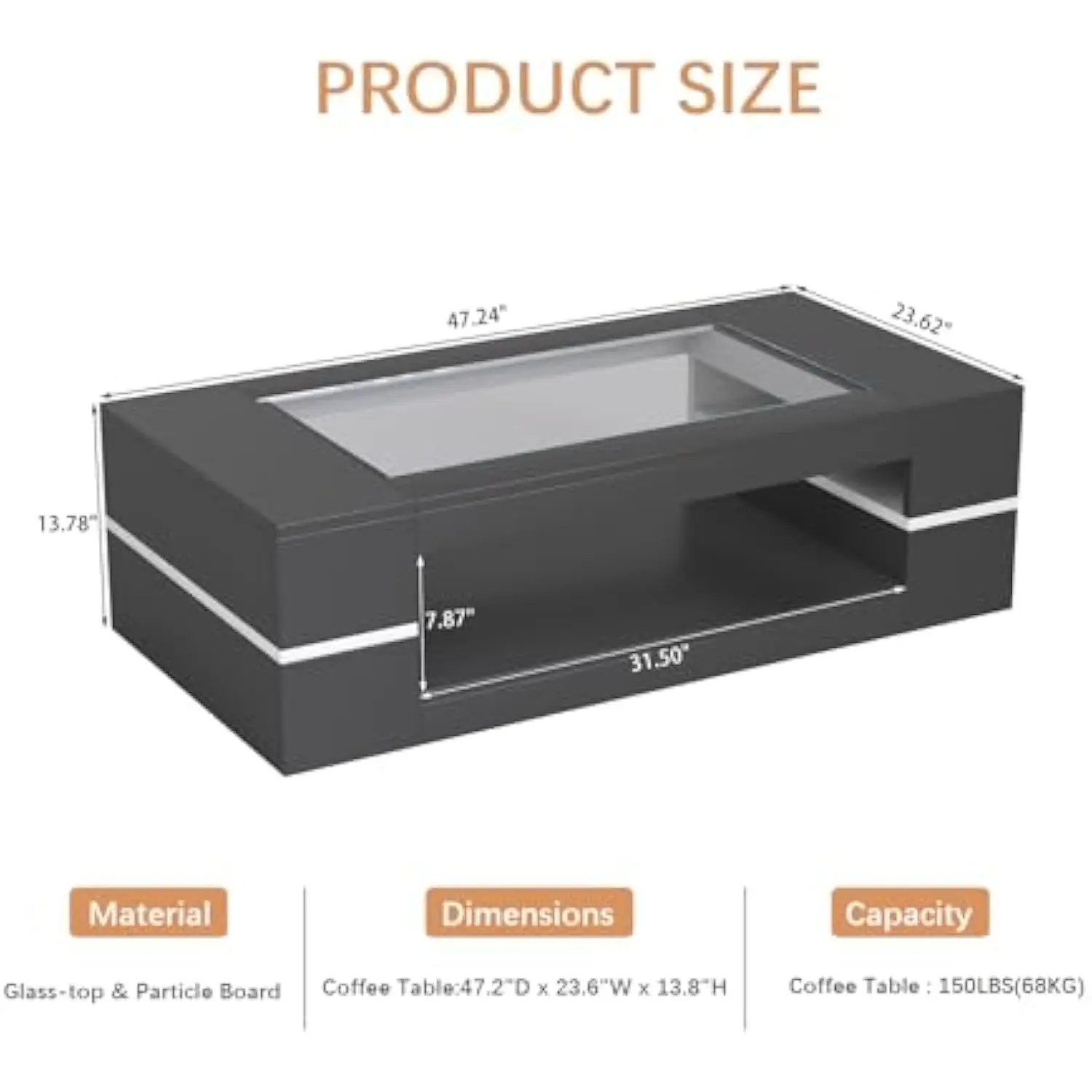
For enhanced safety and durability, many mid-century modern glass top coffee tables feature slightly rounded edges and are supported by sturdy bases that minimize stress points. Glass thickness also matters significantly—tables with 10-12mm thick glass offer substantially better durability than thinner options.
Glass coffee tables are ideal for smaller spaces as they create a visual lightness while still providing substantial functionality. Their easy-clean surface makes them excellent choices for households where spills are common.
Engineered Materials: Modern Durability Solutions
Engineered wood products have evolved significantly, now offering impressive durability that can rival solid wood in many applications. These materials combine natural wood components with adhesives and specialized manufacturing processes to create consistent, stable surfaces.
High-Quality Engineered Wood Options
- Medium-Density Fiberboard (MDF) with Quality Veneer: Dense, uniform core with real wood outer layer; resists warping better than solid wood
- Plywood: Multiple thin wood layers bonded with alternating grain direction; excellent stability and strength
- Particleboard with High-Pressure Laminate: Cost-effective core with extremely durable synthetic surface
Specialized Engineered Materials
- High-Pressure Laminates: Extremely durable synthetic surfaces resistant to scratches, heat, and moisture
- Melamine: Resin-infused paper applied to engineered wood; offers good durability at lower cost
- Phenolic Composites: Advanced materials used in high-wear applications; exceptional durability
Engineered Materials Durability Characteristics
Scratch Resistance: Varies widely by surface material. High-pressure laminates and quality melamines offer excellent scratch resistance, sometimes exceeding solid wood. Veneered surfaces provide similar scratch resistance to the wood species used in the veneer.
Heat Resistance: Moderate to good, depending on the specific surface. Most engineered surfaces withstand brief exposure to hot mugs but can be damaged by very hot items. Using coasters and trivets is recommended.
Water Resistance: Often superior to solid wood, as engineered materials typically incorporate water-resistant adhesives and finishes. High-quality laminates are particularly resistant to moisture damage and staining.
Impact Resistance: Varies by construction quality. Well-made engineered tables with quality cores resist denting well, though edges can be vulnerable to damage.
Quality varies dramatically in this category. Learning to identify real wood coffee tables helps you distinguish between high-quality engineered options and lower-quality imitations. Look for respected brands, substantial weight, quality hardware, and detailed construction as indicators of durability.
Innovative Options: Epoxy and Mixed-Material Tables
The world of coffee table materials continues to evolve, with innovative options that combine remarkable durability with striking visual appeal. These contemporary choices often blend traditional materials with modern technologies to create pieces that are both functional and artistic.
Epoxy Resin Applications
Epoxy resin has revolutionized furniture design, offering glass-like clarity with exceptional durability. Popular applications include:
- River tables combining wood slabs with colored epoxy channels that mimic flowing water
- Full epoxy tops that encapsulate objects, photos, or decorative elements
- Protective coatings over wood or other materials that dramatically enhance durability
Mixed-Material Design Advantages
Tables combining multiple materials often leverage the strengths of each component:
- Metal frames provide structural stability while wood tops offer warmth and character
- Stone inlays in wood create heat-resistant zones for hot items
- Glass inserts protect wood surfaces while maintaining visual interest
Innovative Materials Durability Characteristics
Scratch Resistance: Epoxy offers exceptional scratch resistance, comparable to or exceeding most traditional materials. Quality epoxy surfaces can withstand daily use without showing wear patterns.
Heat Resistance: Moderate to good. Epoxy can typically withstand warm items but may be damaged by very hot objects. Mixed-material designs often incorporate heat-resistant elements specifically for hot items.
Water Resistance: Excellent. Properly cured epoxy is completely waterproof and impervious to most liquids, including alcohol and acidic beverages. This makes it ideal for households concerned about water damage.
Impact Resistance: Good to excellent. Epoxy has some flex that allows it to absorb impacts without cracking. When combined with other materials in thoughtful designs, these tables can offer exceptional durability.
Maintenance for innovative tables typically involves simple cleaning with mild soap and water. Unlike many traditional materials, epoxy and certain mixed-material designs don’t require periodic refinishing or sealing, making them low-maintenance options for busy households.
Material Durability Comparison Chart
| Material | Scratch Resistance | Heat Resistance | Water/Stain Resistance | Impact Resistance | Maintenance Level | Relative Cost | Ideal Use Case |
|---|---|---|---|---|---|---|---|
| Hardwood | 4 | 3 | 3 | 4 | Medium | $$$-$$$$ | Traditional homes with appreciation for natural patina |
| Metal | 5 | 5 | 3-5* | 5 | Low | $$$-$$$$ | High-traffic areas, modern interiors, households with children |
| Stone | 5 | 5 | 2-5** | 3 | Medium-High | $$$$$ | Luxury spaces, design-focused rooms, adult households |
| Tempered Glass | 3 | 3 | 5 | 2 | Low | $$$-$$$$ | Small spaces, minimalist designs, adults without children |
| Engineered Materials | 2-4*** | 3 | 4 | 3 | Low | $$-$$$ | Budget-conscious households, temporary solutions |
| Epoxy/Innovative | 5 | 3 | 5 | 4 | Low | $$$$ | Design enthusiasts, unique spaces, households wanting low maintenance |
* Varies by metal type and finish (stainless steel: 5, untreated iron: 3)
** Varies by stone type and sealing (granite: 4-5, marble: 2-3)
*** Varies significantly by quality and specific material
The standout performers for overall durability are metal and stone, though they have specific limitations. Hardwood offers the best balance of durability factors for most households, while innovative options like epoxy provide excellent all-around performance with striking visual appeal.
Beyond Material: Factors Affecting Coffee Table Durability
While material selection is crucial for coffee table durability, construction quality often plays an equally important role in determining longevity. A table made from premium materials can still fail prematurely if poorly constructed.
Construction Quality Indicators
The joinery techniques used in wooden tables significantly impact structural integrity:
* Mortise and tenon joints: Traditional connections that create exceptionally strong bonds
* Dovetail joints: Interlocking components that resist pulling apart
* Dowel joints: Wooden pegs that reinforce connections
* Finger joints: Interlocking “fingers” that increase glue surface area
Avoid tables with simple butt joints held together only with glue and screws, as these connections weaken over time with regular use.
Support and Base Design
The base design provides critical structural support:
* Tables with four solid legs distribute weight evenly
* Pedestal bases should have wide, heavy footprints to prevent tipping
* Cross-bracing adds significant stability to tables with slender legs
* Corner blocks reinforce the connection between legs and table tops
Look for tables where the base components connect directly to each other rather than relying solely on the top for structural integrity.
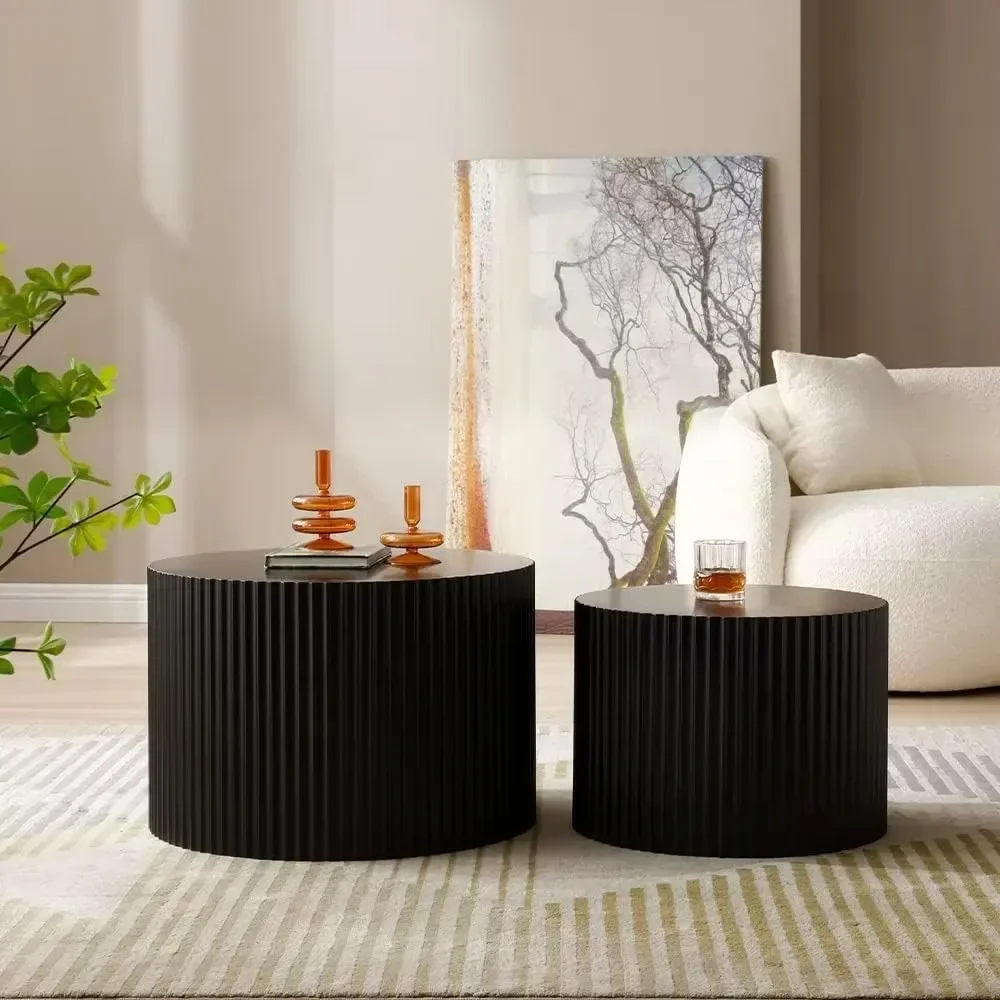
Finishing Techniques
Proper finishing dramatically enhances durability:
* Multiple coats of finish provide better protection than single applications
* Hand-rubbed oil finishes can be easily repaired but require maintenance
* Catalyzed lacquers offer excellent protection with minimal maintenance
* Water-based polyurethanes provide good durability with eco-friendly benefits
Understanding different black mid-century modern coffee table styles helps you appreciate how construction techniques complement material choices in creating durable furniture that maintains its beauty over time.
Matching Durable Materials to Your Lifestyle
Finding the perfect balance between durability and lifestyle needs ensures your coffee table will serve you well for years. Different household compositions and usage patterns call for specific material considerations.
For Families with Young Children
Priority concerns: Impact resistance, safety, repairability
Best materials: Solid hardwood (particularly oak or maple), metal with rounded edges
Avoid: Glass, marble, sharp corners
Why it works: Hardwood can handle impacts, doesn’t show fingerprints easily, and can be refinished if damaged. Metal offers exceptional durability with minimal maintenance.
For Pet Owners
Priority concerns: Scratch resistance, stain resistance, ease of cleaning
Best materials: Stone, metal, high-quality laminate
Avoid: Soft woods, highly polished surfaces that show scratches
Why it works: These materials resist claw marks and can be easily wiped clean of fur and occasional accidents.
For Frequent Entertainers
Priority concerns: Heat resistance, stain resistance, aesthetic appeal
Best materials: Stone, tempered glass, solid hardwood with good finish
Avoid: Materials requiring special care or delicate finishes
Why it works: These surfaces handle hot serving dishes, wine spills, and frequent cleaning without deteriorating.
For Design-Focused Minimalists
Priority concerns: Visual appeal, clean lines, material integrity
Best materials: Quality hardwood, tempered glass, stone
Avoid: Visually busy materials or those requiring heavy maintenance
Why it works: These materials age gracefully while maintaining clean aesthetic appeal.
Considering the shape of your table also impacts durability and functionality. The debate between round vs rectangle coffee tables involves both style preferences and practical considerations—round tables eliminate sharp corners that can be hazardous in active households, while rectangular tables often offer more surface area for the same floor space.
How to Evaluate a Coffee Table’s Durability Before Purchase
When shopping for a durable coffee table, specific evaluation techniques can help you assess quality before making a purchase.
In-Store Evaluation Checklist
- Stability Test: Gently push on opposite corners to check for wobbling
- Weight Assessment: Heavier tables typically indicate solid materials and better construction
- Joint Inspection: Examine how components connect—visible screws often indicate weaker construction
- Drawer Operation: If present, drawers should slide smoothly without catching or sagging
- Finish Quality: Look for consistent color, smooth application, and no rough spots
- Material Authenticity: For wood, look for natural grain variation; for stone, check for natural color variations
Online Shopping Considerations
When purchasing online where physical inspection isn’t possible:
- Read reviews specifically mentioning durability and longevity
- Look for detailed construction specifications
- Check warranty terms—longer warranties typically indicate manufacturer confidence
- Research the reputation of the manufacturer and retailer
- Request material and finish samples when possible
Questions to Ask Retailers
- “What is the core material of this table?” (Look for solid materials rather than veneers over particleboard)
- “How is this table constructed?” (Seek details about joinery techniques)
- “What type of finish is applied and how many coats?” (Multiple coats provide better protection)
- “What maintenance is required?” (Lower maintenance requirements often indicate better durability)
- “How does this table handle heat/water/impacts?” (Listen for specific answers rather than generalities)
Warning signs of poor durability include visible gaps in joints, lightweight construction, vague material descriptions (“wood-like finish”), and extremely low prices compared to similar items.
Frequently Asked Questions About Durable Coffee Table Materials
Which material is absolutely most scratch-resistant?
Granite and tempered glass offer the highest scratch resistance among natural materials. However, certain high-pressure laminates and engineered quartz can be even more resistant to scratching. For maximum scratch resistance in natural materials, granite tops the list, requiring significant force with hard objects to leave marks.
What’s the most child-friendly durable material?
Solid hardwood offers the best balance of durability and safety for households with children. It withstands impacts well, doesn’t have sharp edges like glass or stone can have, maintains a comfortable temperature, and can be refinished if damaged. Metal tables with rounded edges are another excellent option, offering exceptional durability with minimal maintenance requirements.
Are glass coffee tables safe for homes with children?
Tempered glass tables can be reasonably safe if they have rounded edges and thick glass (at least 10mm). However, they still present potential risks if broken. If choosing glass with children present, look for tables with frames that hold the glass securely and consider applying safety film to reduce shattering potential.
Which materials require the least maintenance?
Metal (particularly stainless steel), tempered glass, and high-quality laminates require minimal maintenance, typically needing only regular dusting and occasional cleaning with appropriate products. Stone and wood generally require more specific care and occasional resealing or refinishing to maintain optimal appearance.
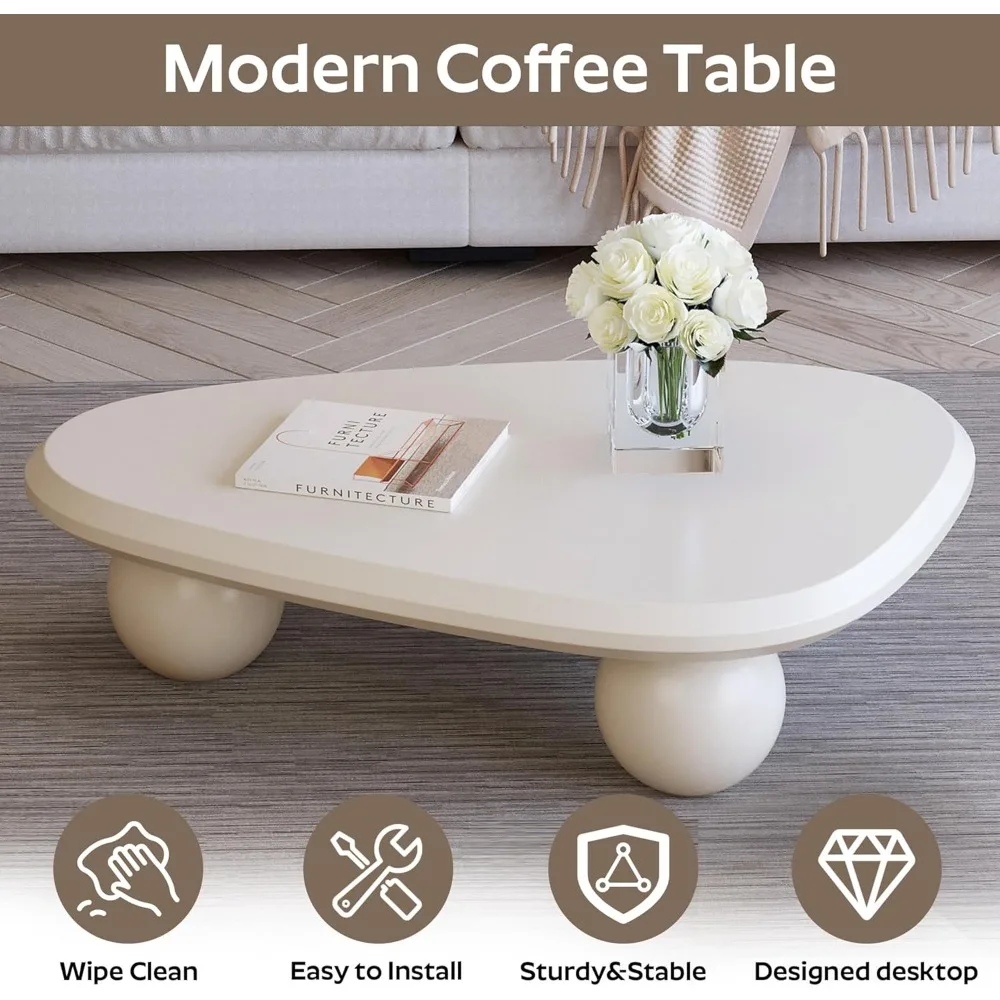
How can I protect my existing coffee table?
Use coasters for drinks, placemats for food items, and trivets for hot objects. Consider applying a high-quality protective finish appropriate for your table’s material. For wood tables, periodic refinishing can restore appearance and protection. Table covers or glass toppers provide significant protection while still allowing the table’s beauty to show through.
Mid-Century Modern Design and Durability: Finding the Perfect Balance
Mid-century modern design principles naturally complement durability considerations, creating coffee tables that stand the test of time both aesthetically and functionally. The mid-century modern movement, with its emphasis on clean lines, organic forms, and honest materials, prioritized furniture that would last generations.
The material choices typical of authentic mid-century design inherently support durability. Solid hardwoods like walnut, teak, and oak feature prominently, selected not only for their beauty but also for their inherent strength and resilience. When metal elements appear, they’re typically well-integrated structural components rather than decorative afterthoughts.
The principles of mid-century modern table design continue to resonate because they combine visual lightness with structural integrity. Tapered legs create visual space while maintaining strength, and gentle organic curves provide both aesthetic appeal and structural support. These tables avoid ornate detailing that can chip or break, instead focusing on the natural beauty of quality materials.
When evaluating reproduction mid-century tables, look for:
- Authentic materials that match the original designs
- Proper proportions that reflect original specifications
- Quality joinery techniques appropriate to the period
- Appropriate finishes that enhance rather than mask the material
- Structural integrity that ensures longevity
At Hearth Forms, our coffee tables honor these principles by combining authentic design with contemporary construction techniques that enhance durability without compromising the original aesthetic vision.
Mid-Century Modern Solid Wood Coffee Tables, Mid-Century Modern Teak Coffee Tables
$879.95 Select options This product has multiple variants. The options may be chosen on the product pageMid-Century Modern Danish Coffee Tables, Mid-Century Modern Oval Coffee Tables, Mid-Century Modern Solid Wood Coffee Tables
$390.05 Select options This product has multiple variants. The options may be chosen on the product pageMid-Century Modern Glass Top Coffee Tables, Mid-Century Modern Glass Top Side & End Tables
$460.58 Select options This product has multiple variants. The options may be chosen on the product pageMid-Century Modern Glass Top Coffee Tables, Mid-Century Modern Vintage Coffee Tables, Mid-Century Modern Vintage Side & End Tables
$725.36 Select options This product has multiple variants. The options may be chosen on the product pageMid-Century Modern Marble Top Coffee Tables, Mid-Century Modern Rectangular Coffee Tables, Mid-Century Modern White Coffee Tables
Price range: $163.28 through $189.22 Select options This product has multiple variants. The options may be chosen on the product pageMid-Century Modern Oval Coffee Tables, Mid-Century Modern Solid Wood Coffee Tables
$679.56 Select options This product has multiple variants. The options may be chosen on the product page
How to Care for Your Durable Coffee Table for Maximum Lifespan
Even the most durable coffee table requires proper care to reach its maximum potential lifespan. Different materials demand specific maintenance approaches to preserve their beauty and functionality.
Wood Care Guide
- Clean regularly with a soft, slightly damp cloth
- Use furniture-specific cleaners that don’t contain silicone or wax buildup
- Apply quality furniture polish or conditioning oil 2-4 times per year
- Address spills immediately to prevent staining
- Use coasters and mats to prevent water rings and heat damage
- Reapply finish every 3-5 years depending on wear and exposure
Stone Care Guide
- Seal granite, marble, and other natural stones according to manufacturer recommendations (typically every 1-3 years)
- Clean with pH-neutral cleaners specifically formulated for stone
- Avoid acidic cleaners (vinegar, citrus) that can etch surfaces
- Blot spills immediately, especially acidic liquids like wine or lemon juice
- Use coasters and trivets to prevent potential etching and staining
For specific guidance on maintaining premium stone surfaces, exploring techniques for cleaning maintaining marble coffee table can help preserve its beauty for decades.
Metal Care Guide
- Dust regularly with a soft cloth
- Clean with mild soap and water, avoiding harsh chemicals
- Apply appropriate metal polish occasionally (type depends on specific metal)
- Touch up any chips in painted or powder-coated surfaces promptly to prevent corrosion
- Apply furniture wax to uncoated metals to prevent oxidation
Glass Care Guide
- Use quality glass cleaner or diluted white vinegar solution
- Clean with microfiber cloths to prevent streaking
- Avoid abrasive cleaners that can scratch the surface
- Check and tighten any hardware that secures the glass periodically
- Use felt pads under decorative items to prevent scratches
Preventative care significantly extends the life of any coffee table. Using appropriate pads under decorative items, addressing spills immediately, and adjusting care seasonally (particularly humidity considerations for wood) helps preserve your table’s appearance and structural integrity.
Sustainability Considerations for Durable Coffee Table Materials
Choosing durable materials for your coffee table represents a fundamentally sustainable decision. Longer-lasting furniture means fewer replacements over time, reducing resource consumption and waste. However, different durable materials carry varying environmental implications worth considering.
Environmental Impact Ratings
Solid Wood: ★★★★☆ (when FSC certified)
* Renewable resource when properly harvested
* Biodegradable at end of life
* Carbon sequestration benefits during growth
* Look for FSC certification ensuring responsible forestry practices
Metal: ★★★☆☆
* Requires significant energy for production
* Highly recyclable (particularly aluminum and steel)
* Extremely long lifespan reduces replacement needs
* Recycled content varies significantly between products
Stone: ★★★☆☆
* Natural material requiring extraction
* Extremely long lifespan
* Energy-intensive quarrying and transportation
* No off-gassing or chemical concerns
Engineered Materials: ★★☆☆☆ to ★★★★☆ (varies widely)
* Quality varies dramatically
* Better options use formaldehyde-free adhesives
* May contain recycled content
* Lower quality options have shorter lifespans
For truly sustainable choices, consider reclaimed wood and recycled metal options that maintain durability while giving materials a second life. These options often feature unique character while reducing environmental impact.
When a table eventually reaches the end of its usable life, consider its recyclability or biodegradability. Solid wood can be repurposed or will naturally decompose, while metals can be fully recycled. Stone can be reused in landscaping or construction, while many engineered materials present more significant disposal challenges.
By choosing durable, sustainable materials for your coffee table, you make a decision that benefits both your living space and the planet for years to come.

